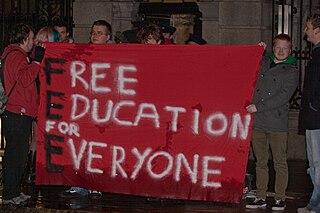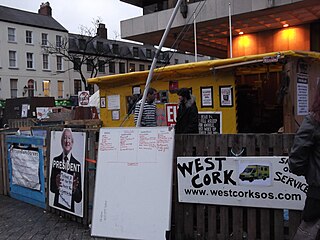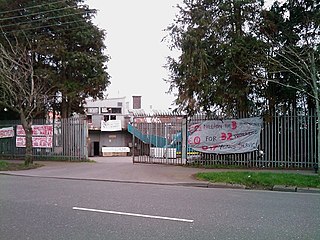 W
WThe post-2008 Irish banking crisis was the situation whereby, due to the Great Recession, a number of Irish financial institutions faced almost imminent collapse due to insolvency. In response, the Irish government instigated a €64 billion bank bailout. This then led to a number of unexpected revelations about the business affairs of some banks and business people. Ultimately, added onto the deepening recession in the country, the banks bailout was the primary reason for the Irish government requiring IMF assistance and a total restructuring of the Irish Government occurred as result of this.
 W
WThe 2012 Irish budget was the Irish Government budget for the 2012 fiscal year, presented to Dáil Éireann in two parts on 5–6 December 2011. It was the first budget of the 31st Dáil, with the first part delivered by Minister for Public Expenditure and Reform Brendan Howlin, and the second part delivered by Minister for Finance Michael Noonan. The budget contained tax increases, and spending cuts of €3.6bn for 2012.
 W
WSavita Halappanavar was an Indian woman, living in Ireland, whose death led to the passing of the Protection of Life During Pregnancy Act 2013. Medical staff at University Hospital Galway denied her request for an abortion following an incomplete miscarriage on the grounds that granting her request would be illegal under Irish law, ultimately resulting in her death from septic miscarriage. Her death served as a rallying cry for efforts to repeal the Eighth Amendment of the Constitution of Ireland, which prohibited abortion in most instances.
 W
WThe post-2008 Irish economic downturn in the Republic of Ireland, coincided with a series of banking scandals, followed the 1990s and 2000s Celtic Tiger period of rapid real economic growth fuelled by foreign direct investment, a subsequent property bubble which rendered the real economy uncompetitive, and an expansion in bank lending in the early 2000s. An initial slowdown in economic growth amid the international financial crisis of 2007–08 greatly intensified in late 2008 and the country fell into recession for the first time since the 1980s. Emigration, as did unemployment, escalated to levels not seen since that decade.
 W
WH.N. v Minister for Justice, Equality and Law Reform and others, [2012] IESC 58; [2013] 1 IR 142, is an Irish Supreme Court case in which the Court referred the following question to the Court of Justice of the European Union for preliminary ruling in accordance with Article 267 Treaty on the Functioning of the European Union (TFEU):Does Council Directive 2004/83/EC, interpreted in the light of the principle of good administration in the law of the European Union and, in particular, as provided by Article 41 of the Charter of Fundamental Rights of the European Union, permit a Member State, to provide in its law that an application for subsidiary protection status can be considered only if the applicant has applied for and been refused refugee status in accordance with national law?
 W
WOccupy Dame Street (ODS) or Occupy Dublin was a peaceful protest and demonstration against economic inequality, social injustice and corporate greed taking place outside the Central Bank of Ireland plaza on Dame Street in Dublin, beside the Temple Bar area of the city. Part of the global Occupy movement, it took its name from the Occupy Wall Street demonstration in New York City's Wall Street financial district. Occupy Dame Street had four requests: the withdrawal of the EU/IMF from Ireland, an end to public ownership of private debt, the return to public ownership of Ireland's privatised oil and gas reserves, and the implementation of what the movement describes as "real participatory democracy". The national police force, Garda Síochána, dismantled their camp during a late-night raid on 8 March 2012. The protesters vowed to fight on. Some were never heard of again, while others found other channels of protest. The most detailed account and analysis of events was written by Helena Sheehan.
 W
WThe Occupy Wall Street protests have inspired a wide international response. There have been hundreds of Occupy movement protests worldwide over time, intended and organized as non-violent protest. This is a list of some of their locations. Months before the Occupy movement began, the Movimiento 15-M planned to hold events in many nations on October 15, 2011. The Occupy movement joined in and also held many events in many nations on that day. A list of proposed events for the 15 October 2011 global protests listed events in 951 cities in 82 countries. Reportedly the large manifestation in Rome ended in violence. Protest camps were built at many of the protest locations from Honolulu to Zeulenroda, often near banking institutions or stock markets. Many locations had further manifestations at the following weekends until "Guy-Fawkes" day since the Guy Fawkes mask had become protester fashion. Many US-American Occupy groups kept activity alive until spring 2012, some are still active.
 W
WThe Vita Cortex sit-in was a peaceful protest at the Vita Cortex plant on the Kinsale Road in Cork, Ireland, which began on 16 December 2011 after workers were made redundant without pay with immediate effect. The dispute led to nationwide protests, television appeals and debates in Dáil Éireann. According to the trade union UNITE, the dispute was part of a growing trend of workers being "left in the cold" after being made redundant.
 W
WZappone & Gilligan v. Revenue Commissioners & Ors [2006] IEHC 404 was a High Court case which was one of the first major events in the debate on the recognition of same-sex marriage in Ireland. The plaintiffs Ann Louise Gilligan and Katherine Zappone unsuccessfully sought recognition of their Canadian marriage.